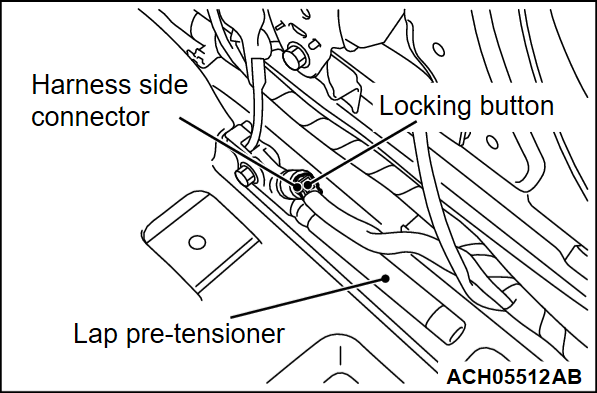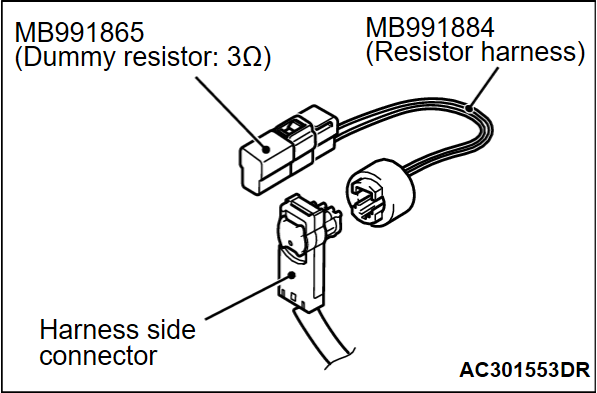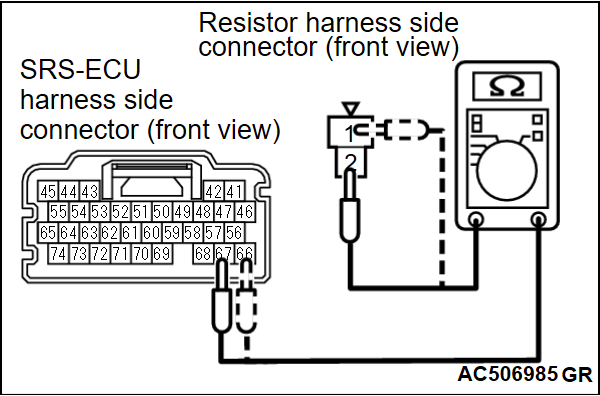DTC B1620 Lap pre-tensioner (LH) (squib) system (open circuit of squib circuit)
| caution | If DTC B1620 is set in SRS-ECU, be sure to diagnose the CAN bus line. |
OPERATION
Only when the frontal impact exceeding the threshold is simultaneously detected (turned ON) by the front impact sensor as well as by the analog G-sensor and safing G-sensor in SRS-ECU, the electric current is supplied from SRS-ECU to the lap pre-tensioner (LH) (squib).
TROUBLE JUDGMENT
The code is set when the open circuit occurs to the SRS-ECU passenger's lap pre-tensioner (LH) (squib) circuit.
PROBABLE CAUSES
- Poor contact of connector
- Open circuit to lap pre-tensioner (LH) (squib) circuit
- Malfunction of SRS-ECU
DIAGNOSIS
STEP 1. Using scan tool (M.U.T.-IIISE), diagnose the CAN bus line.
(1)
| caution | To prevent damage to scan tool (M.U.T.-IIISE), always turn the ignition switch to the "LOCK" (OFF) position before connecting or disconnecting scan tool (M.U.T.-IIISE). |
(2) Turn the ignition switch to the "ON" position.
(3) Diagnose the CAN bus line.
(4) Turn the ignition switch to the "LOCK" (OFF) position.
Is the CAN bus line found to be normal?
STEP 2. Using scan tool (M.U.T.-IIISE), check whether the DTC is set again.
(1) Connect the negative battery terminal.
(2) After erasing the DTC memory, check the DTC again.
(3) Disconnect the negative battery terminal.
Is DTC B1620 set?
STEP 3. Diagnosis check by dummy resistor connection.
(1) Check that the negative battery terminal is disconnected. If the negative battery terminal is connected, disconnect it.
(2) Use the flat-tipped screwdriver to pull out the locking button of harness side connector. After releasing the lock, disconnect the lap pre-tensioner (LH) harness side connector.
(3) Connect the special tool dummy resistor (MB991865) to the special tool resistor harness (MB991884).
(4) Connect the special tool resistor harness to the lap pre-tensioner (LH) harness side connector.
(5) Connect the negative battery terminal.
(6) After erasing the DTC memory, check the DTC again.
(7) Disconnect the negative battery terminal.
Is DTC B1620 set?
STEP 4. Resistance measurement at the SRS-ECU connector and the lap pre-tensioner (LH) connector.
(1) Check that the negative battery terminal is disconnected. If the negative battery terminal is connected, disconnect it.
(2) Disconnect the SRS-ECU connector.
(3)
Use the flat-tipped screwdriver to pull out the locking button of harness side connector. After releasing the lock, disconnect the lap pre-tensioner (LH) harness side connector.
| danger | Disconnect this lap pre-tensioner (LH) connector, and keep the squib circuit shorted. |
(4) Connect special tool resistor harness (MB991884) to the removed lap pre-tensioner (LH) harness side connector.
(5) Take the measurements below at the resistor harness and SRS-ECU harness side connector.
- Continuity PD2- line between SRS-ECU connector and lap pre-tensioner (LH) harness connector
- Continuity PD2+ line between SRS-ECU connector and lap pre-tensioner (LH) harness connector
OK: The resistance should be 2 ohms or less
Is the check result normal?
 Repair the wiring harness PD2-, PD2+ line between the SRS-ECU connector and the lap pre-tensioner (LH) connector.
Repair the wiring harness PD2-, PD2+ line between the SRS-ECU connector and the lap pre-tensioner (LH) connector.![[Previous]](../../../buttons/fprev.png)
![[Next]](../../../buttons/fnext.png)




